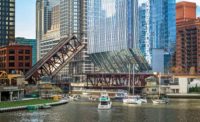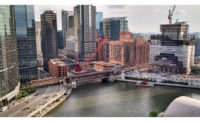Resisting Overturning
The caissons will resist the overturning moment of the slender tower and keep the building from sliding into the river. "The foundations are working really hard," says Chmielowski. All of the development's foundation types—caissons, micropiles and more—were chosen due to site constraints, says Chris Phares, project executive for builder Clark Construction Group-Chicago LLC.
The construction-management strategy also was site-inspired. To increase access and extend the work area, Clark turned to river barges for materials delivery, including for the river wall, the H-piles, the imported backfill and the structural steel, among other elements. For example, workers use barges to transport clean clay spoil and install the river wall and H-piles. Furthermore, barge-mounted cranes are employed to pick precast and structural steel and also for tower-crane erection.
To date, there has been only one mishap. On Oct. 17, a barge broke in half under the weight of the spoils from the caisson operation. No one was hurt. After it was emptied, the broken barge was refloated out, on Nov. 8. The barge is currently under inspection in a dry dock to determine the cause of the break.
The biggest ongoing inconvenience is working around Amtrak trains. Crews from Guy F. Atkinson, a division of Clark, are generally limited to installing the platform's one hundred 120-ft-long micropiles during a graveyard shift—from 12:40 a.m. to 5 a.m.—when there are no trains. Work, which started at the end of October and is set to wrap up in February, is taking about twice as long as it would otherwise, says Phares.
The tower's caisson operation, just recently completed, had its own challenges. Usually, the contractor would have used two drill rigs, but the site was too small for that, says Dan Bien, vice president of Case Foundation Co. To make the schedule, Case had to add a night shift.
Because there was no site storage, the caisson's 120-ft-long steel casings were trucked in just in time for installation. Case also trucked in the 110-ft-long rebar cages, fabricated off-site in three lengths.
The development is set for completion in fall 2016. The challenges are worth it, says Scacco. If the site had been easy to access, "it would have been the most expensive one in the city," he says.










Post a comment to this article
Report Abusive Comment